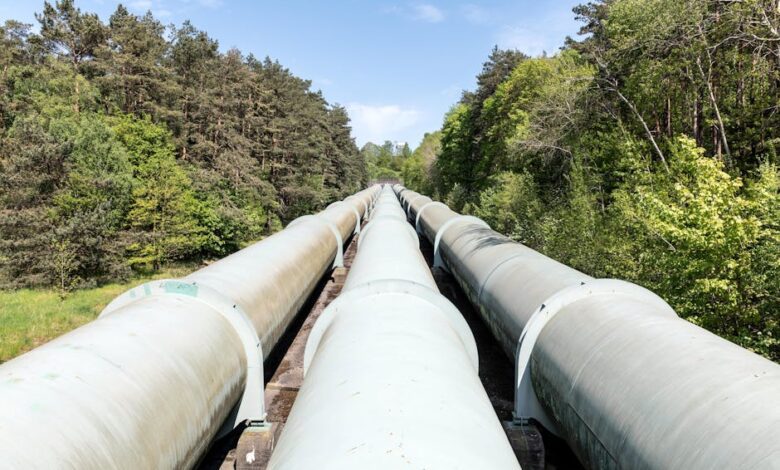Unlocking Energy Potential: The Impact of Natural Gas and Oil Co-Production on Global Market Trends and Future Technologies

In an era where energy demands are evolving rapidly, the co-production of natural gas and oil has emerged as a pivotal strategy for optimizing resource extraction and enhancing energy security. This innovative approach not only streamlines the joint extraction and processing of these two energy giants but also significantly influences global oil market trends. As the interplay between crude oil and natural gas becomes increasingly complex, understanding this synergy is essential for stakeholders in the oil and gas industry, from investors to policymakers. In this article, we will delve into the implications of natural gas and oil co-production, examining its impact on oil prices, the future of oil technologies, and the environmental challenges that arise from balancing oil consumption with sustainable practices. Join us as we explore how this dynamic relationship shapes the global oil trade, the role of OPEC, and the evolving landscape of oil exploration and production, ultimately paving the way for a more secure and sustainable energy future.
- 1. "Understanding the Synergy: Natural Gas and Oil Co-Production and Its Impact on Global Oil Market Trends"
- 2. "The Future of Oil and Natural Gas: Exploring Joint Extraction Technologies and Their Role in Energy Security"
1. "Understanding the Synergy: Natural Gas and Oil Co-Production and Its Impact on Global Oil Market Trends"
Understanding the synergy between natural gas and oil co-production is essential for grasping current trends in the global oil market. As the demand for energy continues to rise, the joint extraction and processing of natural gas and crude oil have emerged as a strategic approach that enhances efficiency, reduces costs, and maximizes resource utilization. This integrated method allows companies to optimize oil refining processes while simultaneously catering to the growing market for natural gas, a cleaner alternative to traditional oil consumption.
The oil market trends have been significantly influenced by the rise of shale oil production and the advent of advanced oil technologies, which have made it possible to extract crude oil and natural gas from previously inaccessible reserves. This shift is particularly evident in the United States, where the shale boom has reshaped global oil trade dynamics, impacting oil prices and the overall energy landscape. The increase in domestic production has led to a more competitive environment, reshaping oil supply chains and altering the geopolitical landscape, especially concerning OPEC's influence.
Moreover, the co-production process enhances energy security by diversifying the energy portfolio. By optimizing the extraction and refining of both natural gas and crude oil, countries can better manage their oil reserves and reduce dependency on single sources, thus mitigating risks related to geopolitical tensions and oil price volatility. As nations navigate the complexities of oil regulation and compliance, the efficient management of oil storage and transportation becomes paramount, ensuring that both natural gas and crude oil can be moved seamlessly through established oil pipelines.
The environmental impact of oil extraction and consumption remains a critical concern. As stakeholders increasingly recognize the importance of sustainability, the role of biofuels and oil alternatives is gaining traction. Co-production offers a pathway to decrease the environmental footprint of oil operations, allowing for a more sustainable approach to energy production. By embracing technologies that enhance the efficiency of oil field services, companies can adopt practices that align with global efforts to minimize greenhouse gas emissions.
In conclusion, the co-production of natural gas and oil represents a strategic advantage in today’s complex oil market. By leveraging the synergy between these two resources, stakeholders can navigate the challenges of oil price hedging, enhance energy security, and contribute to the ongoing discourse on sustainable energy practices. As the global oil landscape continues to evolve, understanding the implications of co-production on oil market trends will be crucial for investors, policymakers, and industry leaders alike.
The co-production of natural gas and oil has become an increasingly significant practice in the energy sector, optimizing resource extraction and enhancing energy security globally. By jointly extracting and processing these hydrocarbons, companies can maximize their operational efficiency while addressing fluctuating oil prices and evolving market dynamics.
In regions rich in both crude oil and natural gas, such as the United States with its shale oil formations, co-production enables producers to capitalize on the synergies between oil and gas extraction. This method not only reduces operational costs but also streamlines oil supply chains, particularly in the context of oil transportation and storage. As oil market trends shift, the ability to tap into both resources can provide a buffer against the volatility often seen in the oil prices.
The impact of co-production extends beyond immediate economic benefits; it also plays a crucial role in reducing the environmental impact of oil exploration. By utilizing advanced oil technologies and compliance measures, companies can minimize their carbon footprint while optimizing oil refining processes. Moreover, as the global oil trade evolves, co-production operations can enhance the competitiveness of oil companies against emerging oil alternatives, such as biofuels and other renewable energy sources.
The regulatory landscape surrounding oil exploration and production is also vital. With organizations like OPEC influencing oil market dynamics, adherence to oil regulations becomes paramount for companies engaged in co-production. These regulations often dictate the methods of extraction and processing to ensure environmental compliance and sustainability, which is increasingly important to consumers and investors alike.
As the demand for petrochemicals and downstream oil products continues to rise, the strategic co-production of oil and natural gas presents a pathway for ensuring energy security. It allows for a more diverse portfolio of energy resources, which can mitigate risks associated with geopolitical tensions and shifting oil consumption patterns. In this context, oil price hedging strategies become essential for companies to protect their investments and maintain profitability amidst uncertain market conditions.
Overall, the joint extraction of oil and natural gas not only enhances operational efficiency but also supports the broader goals of sustainability and energy security, making it a critical component of the future of the energy sector.
*(Image: Oil rigs co-producing natural gas and crude oil – Source: Energy Industry Report)*
2. "The Future of Oil and Natural Gas: Exploring Joint Extraction Technologies and Their Role in Energy Security"
The future of oil and natural gas is increasingly intertwined with the advancement of joint extraction technologies, which promise to enhance energy security while addressing the evolving challenges of the oil market. As global oil trade dynamics shift, driven by OPEC decisions and the growing prominence of shale oil, the need for efficient and sustainable extraction methods has never been more critical.
Joint extraction methods involve the simultaneous recovery of oil and natural gas from the same reservoir, optimizing resource utilization and minimizing the environmental impact of oil operations. As oil prices fluctuate and oil market trends indicate a potential shift towards biofuels and oil alternatives, companies are exploring innovative technologies to enhance oil field services and improve oil refining processes.
One promising avenue is the development of advanced offshore drilling techniques that allow for deeper and more efficient extraction of hydrocarbons. These technologies not only facilitate access to previously untapped oil reserves but also align with stringent oil regulation and compliance requirements aimed at reducing the environmental footprint of oil consumption. Additionally, advancements in oil transportation and storage solutions are crucial for maintaining robust supply chains, ensuring that crude oil and natural gas can be moved efficiently from extraction sites to refining facilities and global markets.
The interplay of oil geopolitics and the future of energy security will largely depend on how these joint extraction technologies are adopted. As nations scramble to secure their energy future, the ability to leverage both oil and natural gas resources will be paramount. This dual approach can mitigate the risks associated with fluctuating oil prices and enhance oil price hedging strategies, ultimately providing a buffer against market volatility.
Furthermore, the integration of petrochemicals in downstream oil processes can lead to innovative products that reduce dependency on traditional fossil fuels. This transition is vital as the world increasingly turns its focus toward sustainability and reducing the environmental impact of oil extraction and consumption.
In conclusion, the exploration of joint extraction technologies represents a significant step towards a more secure and sustainable energy future, balancing the demands of the oil market with the urgent need for environmental stewardship. As the industry evolves, embracing these advancements will be essential for maintaining energy security and adapting to the changing landscape of global energy consumption.
In conclusion, the co-production of natural gas and oil represents a pivotal advancement in the energy sector, offering multifaceted benefits that extend from enhanced efficiency in extraction to significant implications for global oil market trends. As we've explored, the synergy between these two vital resources not only helps in optimizing oil refining processes but also plays a crucial role in ensuring energy security as nations navigate the complexities of oil geopolitics and fluctuating oil prices.
The adoption of innovative joint extraction technologies is set to reshape the future of oil and natural gas, empowering oil field services to better manage oil reserves while minimizing the environmental impact of oil extraction. Furthermore, the integration of shale oil and offshore drilling practices stands to bolster oil supply chains, enhancing the reliability of oil transportation and storage systems.
As oil investing becomes increasingly intertwined with the dynamics of natural gas, stakeholders must remain vigilant in their oil price hedging strategies to navigate the ever-evolving landscape of the global oil trade. The potential for biofuels and oil alternatives looms large, offering pathways to reduce dependency on traditional oil consumption while promoting sustainability.
Ultimately, the ongoing collaboration between natural gas and oil sectors will be critical in addressing future energy challenges and ensuring that the benefits of oil technologies and regulations are harnessed responsibly. By staying attuned to these developments, industry professionals and investors alike can better position themselves in a rapidly changing energy market.
—
By emphasizing the interconnectedness of natural gas and oil co-production, this conclusion reinforces the article's insights while strategically incorporating SEO keywords to enhance visibility.





